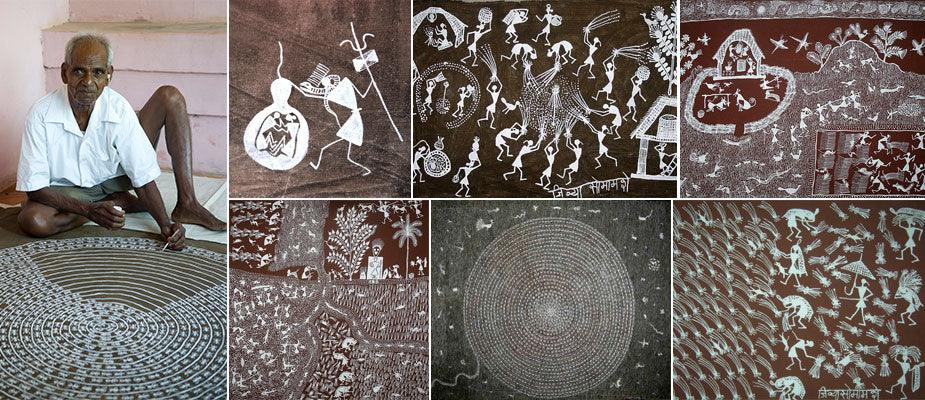
Meet The Warlis #HandmadeInIndia
Share
In today’s episode of Handmade in India, we head to Maharashtra and Gujarat to meet The Warlis. Welcome aboard.
The Warlis or Varlis are an indigenous tribe living in mountainous as well as coastal areas of Maharashtra and Gujarat. They speak an unwritten Varli language which belongs to the southern zone of the Indo-Aryan languages (just saying).
The Art of the Warlis
In the book The Painted World of the Warlis, Yashodhara Dalmia claimed that the Warlis carry on a tradition of artistic expression stretching back to 2500 or 3000 BCE. Those in the know will know that the mural paintings by the Warlis are quite similar to those done between 500 and 10,000 BCE in the Rock Shelters of Bhimbetka, in Madhya Pradesh.

Rock Shelters of Bhimbetka, in Madhya Pradesh (Left); Warli Painting (Right)
Literal Definition
The word Warli is derived from waral meaning piece of land or field. Waral was the name given to a piece of land that was extracted out of an abandoned area, and then used to undertake cultivation.
Production Cluster
|
The Warli tribe resides in parts of
|
Inside Warli Art
The wall paintings by the Warlis use a very basic graphic vocabulary: a circle, a triangle and a square. The circle and triangle come from their observation of nature – the circle representing the sun and the moon, the triangle derived from mountains and pointed trees. The central motive in each ritual painting is the square, known as the "chauk" or "chaukat", mostly of two types: Devchauk and Lagnacha Chauk.
Devchauk (God's Square): It is made with an outline of a square drawn on the inside of the house wall. They start filling up the squarish frame towards inside from these four lines with geometrical strips. In the corners, you find figures of the moon, the sun, a comb, a ladder, the tarpa (a wind musical instrument) and ghangli (a string instrument). In the center of the Devchauk, we find Palaghata, the mother goddess, symbolizing fertility. Other characters in the traditional painting are Pancha Sirya Dev, the five headed god and the headless warrior, who is drawn either in a standing position or riding a horse. Pancha Sirya Dev is the archaic symbol of the cosmic cycle of life and death.

Devchauk (Image courtesy: D’Source)
Lagnacha Chauk (Marriage Square): In this painting a decorative square is drawn and in its centre a suhasinis (married women) draw a horse on which the bride, groom and groom’s sister is shown sitting. Around the horse are the dancers, musicians and dhavelris (women who perform the wedding).

A wedding scene… the bride and the groom riding a horse, being trailed by more revelers (Image courtesy: One Hot Stove)
The Tarpa Dance: One of the distinct characteristic of Warlis is their love for music, dance and liquor. They have been dancing to the tune of the tarpa (a wind musical instrument) for centuries. The tarpa is a long protruding, phallic shape instrument made by the Warlis themselves and its size varies from one to six feet. It is considered to be an instrument given to the Warlis by Narandeva itself.
Traditionally, the Tarpa dance is performed by youngsters while elderly people just watch it. The dancers form a circle around the tarpa player and move in an anticlockwise direction - never turning their back to the Tarpa. This is so because the Warlis believe that cosmic forces move anticlockwise.
On Diwali, the festival of lights, as the lamps are lit and firecrackers go off, the Tarpa, the Warli pipe is used to summon young couples of the village to dance in a ring. It is a merry-go-round of light and sound and festivity. The Tarpa dance is also one of the important themes of Warli paintings.

The Tarpa Dance
The central motif in all these ritual paintings is surrounded by scenes portraying hunting, fishing and farming, festivals and dances, trees and animals. Human and animal bodies are represented by two triangles joined at the tip; the upper triangle depicts the trunk and the lower triangle the pelvis. Their precarious equilibrium symbolizes the balance of the universe, and of the couple.
The pared down pictorial language is matched by an equally spare technique. The ritual paintings are usually done inside the huts. The walls are made of a mixture of branches, earth and cow dung, making a Red Ochre background for the wall paintings. The Warli use only white for their paintings; the white pigment is a mixture of rice paste and water with gum as a binding. The ‘paintbrush’ is a bamboo stick chewed at the end to make it as supple as a paintbrush.
The wall paintings are created mostly for special occasions such as weddings or harvests. This activity was a preserve of the womenfolk until the late 1970s, which is when Jivya Soma Mashe revolutionised the world of Warli Art.
Other Warli Paintings
Kanna: There is another squarish painting, known as kanna - the symbol of virginity. This painting is drawn only in the bride’s house. A multiplication sign is prominent in the square. The figure is then coated with yellow turmeric powder, red kunku powder and orange shendur powder to make it colourful and attractive.
Muthi: Muthi, means fists. And muthi paintings are repetitive imprints of fists - each signifying a fistful of grains. The multiplicity of such fist prints is supposed to ensure an abundance of food in the home and abundant yield in the field. Muthi paintings are usually found on the front walls of the house, granaries, inner walls of the kitchen, ploughs, on baskets which are used for keeping bhakari (bread).

Muthi: Fist Imprints
Jivya Soma who?
Jivya Soma Mashe (born in 1934) is one of the best known artists of Warli Art. He was born in Dhamangaon village in Talasari taluka of Thane district of Maharashtra. At the tender age of 11, he came to Kalambipada village in Dahanu taluka, which is where he presently lives.

In the 1970s, Warli Painting, a predominantly ritual art till that time, took a radical turn when Jivya Mashe started to paint not for any special ritual, but on an everyday basis.
His talent was soon noticed nationally and internationally. The first exhibition of Jivya was held at the Gallery Chemould, Jehangir Art Gallery in Mumbai in 1975 by the initiative of Bhaskar Kulkarni, who first introduced this master to the outside world. Since then he has held several exhibitions in France, Germany, Italy & United States. This brought unprecedented recognition to the world of Warli Art and prompted many other young men to follow suit. Since then, Warli Art has gained fame across India and the world.
Jivya Soma Mashe sums up the deep feeling which animates the Warli people, saying "There are human beings, birds, animals, insects, and so on. Everything moves, day and night. Life is movement"
Awards & Honours
- In 1976, Jivya Soma Mashe received the National Award for the Tribal Art.
- In 2002, he received the Shilp Guru award.
- In 2009, he was the recipient of the Prince Claus Award for his Warli painting.
- In 2011, he received the Padma Shri for his contribution towards Warli painting.
Leaving a Legacy
Jivya has two sons Sadashiv Soma Mashe (born 1960) and Balu Jivya Mashe (born 1968/1972) - and both are well known exponents of this art form. Jivya has transmitted his knowledge to his children, telling his sons the Warli tales and legends. Both use a pictorial style that's close of their father - maintaining the tradition of a master-student relationship.
Our Favourite Warli Art Master - Shantaram Chintya Tumbada
Shantaram, born in 1975, is a master in the art of the representation of movement and an imaginative storyteller. Apart from painting, he cultivates three acres of rice field with his wife Kamla in Thane.

Shantaram's works include a huge mural on a wall of the six-storeyed Tony Garnier museum in Lyon, France. The mural is a whirl of activity - babies in cradles, a market scene, bulls ploughing a field - capturing the various facets of life in his village.

Tony Garnier Urban Museum, Lyon, 1993
The wall painting had been created as part of the Tony Garnier urban museum in which five painted walls represented five continents.
Madhukar Vadu
You must also read the fascinating story of Madhukar Vadu, who had not studied beyond class ten, but ended up publishing several books on the tribal art of Warli paintings in German. Each book is a collection of Warli paintings created by Vadu with a narrative describing the stories depicted in the nuanced works of art. More than 100,000 copies of his books have sold in Germany alone. Here's his story »
Warli Around the Web
a. If the written and printed word is not quite your thing, there’s always the gift of YouTube, the site that never stops giving. The world of Warli Art is beautifully documented here. Here you will find tutorials, videos, and conversations about the creators of this simple and expressive art form. A accessible place to begin your journey is here:
b. Now the style of Warli Art is so eye-catching, it lends itself beautifully to the art of Pinterest-ing (if one can call it such a thing). And the thing about Pinterest is it quickly gets very addictive (there’s a scientific reason for this). But if you love the look of Warli Art already and have come with us so far, we’re sure you’ll enjoy this trip into Warli on Pinterest, too.
c. Shop for Warli: We all know art and shopping are both therapeutic, and so we've curated a whole section of products inspired by Warli Art. Get some therapy.
|
|
|
|
|
|
Coke & Warli Art
Did you know: Warli art featured in Coca-Cola's 'Come home on Diwali' ad campaign in 2010.
Research Links
- Balu Mashe's Blog
- Biodiversity of India: Warli tribe and their tribal art
- Business Standard: Coca-Cola India celebrates ancient Warli folk art form
- Handmade in India: A Geographic Encyclopedia of India Handicrafts by Aditi Ranjan & M.P. Ranjan
- india.gov.in Archive: Warli Folk Painting
- Indian Art Collection
- Jivya Soma Mashe's Blog
- One Hot Stove: Warli Paintings
- Paramparik Karigar: Jewels in our Crown: Master Craftsman Jivya Soma Mashe Padma Shri Awardee
- Sadaahiv Soma Mashe's Blog
- Shantaram Chintya Tumbada's Blog 1
- Shantaram Chintya Tumbada's Blog 2
- The Art of Warli painting from Maharashtra - A film by Chhatrapati Shivaji Maharaj Vastu Sangrahalaya - Mumbai
- The Better India: Art & Culture: The Warlis – The painting is on the wall
- The Crafty Angels: A Complete Warli painting Tutorial Guide
- The Hindu: Whirls of White
Note: To browse through all the posts in the 'Handmade in India' series, click here.




